 Note
di colore fra i grigi del bianco e nero Note
di colore fra i grigi del bianco e nero
di
Roberto Palmas (figlio di Giuseppe Palmas) Un'esposizione
delle foto di Giuseppe Palmas non sarebbe completa senza considerare l'aspetto
sociale. Nella sezione Cronaca e Costume ho voluto far rientrare tutti
quei personaggi ed avvenimenti che hanno colorato, sia con toni allegri
che tristi, una nazione intenta a leccarsi le ferite lasciate dalla Seconda
Guerra Mondiale. Comincerò dalla cronaca, raccolta all'inizio della
sua carriera solo sul block notes e in un secondo tempo impressa anche
sulla pellicola.
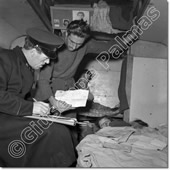 Sono
piccoli fatti di cronaca nera, quasi a non volersi staccare dal mestiere
di giornalista, a dare a Palmas l'occasione di dimostrare il suo talento
fotografico, complice qualche gomitata per garantirsi l'inquadratura migliore.
Tutti i più importanti processi del primo dopoguerra lo vedono
in prima linea a cercare di fermare l' espressione di rabbia dell'imputato
alla lettura del verdetto o, come nel caso della contessa Maria Pia Bellentani,
la gioia della scarcerazione. Una particolare attenzione è rivolta
ai barboni e alla gente che ha perso tutto a causa della guerra. Molto
significativo, a riguardo, il servizio effettuato nel '51 durante il "Censimento
dei senzatetto". I poveri che abitano in baracche ricavate dalle
macerie della guerra sono svegliati da poliziotti, nel cuore della notte,
per poter effettuare un controllo. Queste foto "sociali" mostrano
come i problemi per l'Italia avviata al boom economico siano tutt'altro
che risolti. Sono
piccoli fatti di cronaca nera, quasi a non volersi staccare dal mestiere
di giornalista, a dare a Palmas l'occasione di dimostrare il suo talento
fotografico, complice qualche gomitata per garantirsi l'inquadratura migliore.
Tutti i più importanti processi del primo dopoguerra lo vedono
in prima linea a cercare di fermare l' espressione di rabbia dell'imputato
alla lettura del verdetto o, come nel caso della contessa Maria Pia Bellentani,
la gioia della scarcerazione. Una particolare attenzione è rivolta
ai barboni e alla gente che ha perso tutto a causa della guerra. Molto
significativo, a riguardo, il servizio effettuato nel '51 durante il "Censimento
dei senzatetto". I poveri che abitano in baracche ricavate dalle
macerie della guerra sono svegliati da poliziotti, nel cuore della notte,
per poter effettuare un controllo. Queste foto "sociali" mostrano
come i problemi per l'Italia avviata al boom economico siano tutt'altro
che risolti.
E'
l'alluvione del Polesine nel novembre del 1951 il vero battesimo del Palmas
fotoreporter. Durante i giorni passati fra le acque del Po il cesenate
capisce l'importanza della macchina fotografica quale strumento di testimonianza.
Quella tragedia si rivela un duro colpo per un paese che sente ancora
l'eco dei bombardamenti. Nonostante tutto l'Italia rialza un'altra volta
la testa e il fotografo ritorna in quei luoghi anche per testimoniarne
la ricostruzione, fisica e morale.
 Un altro evento
importante di cronaca raccontato dalla fotocamera di Giuseppe Palmas è
il ritorno dei reduci dalla Russia, a quasi dieci anni di distanza dalla fine
del conflitto. Uomini che ormai vengono dati per dispersi sono invece riusciti
a sopravvivere non solo alla guerra, ma soprattutto ai lunghi rigidi inverni
della steppa. E così nel '54 il flash ritrae queste figure misteriose
mentre scendono dal treno, spaesate, con la barba lunga ma con un sorriso
che segna la fine di un incubo. Un altro evento
importante di cronaca raccontato dalla fotocamera di Giuseppe Palmas è
il ritorno dei reduci dalla Russia, a quasi dieci anni di distanza dalla fine
del conflitto. Uomini che ormai vengono dati per dispersi sono invece riusciti
a sopravvivere non solo alla guerra, ma soprattutto ai lunghi rigidi inverni
della steppa. E così nel '54 il flash ritrae queste figure misteriose
mentre scendono dal treno, spaesate, con la barba lunga ma con un sorriso
che segna la fine di un incubo.
La
vocazione per tutto quello che è cronaca lo porta a diversi servizi
di prestigio soprattutto in campo politico. Con Luigi Barzini jr, giornalista
di Epoca, sale sull'aereo personale dello Scià di Persia
che fa ritorno in patria dopo un esilio dovuto ad un colpo di stato. Non
c'è molta luce su quel volo, ma Palmas si prende tutto il tempo
che è necessario per fotografare Reza Palhevi, finalmente rilassato
e sereno. Come spesso capita in queste occasioni, il fotografo chiede
poi ad un collega di ritrarlo insieme allo Scià, quasi a voler
diventare per un attimo protagonista, come succede in teatro quando il
regista alla fine dello spettacolo esce da dietro le quinte e va sul palcoscenico
a godersi i meritati applausi.
Anche
i politici italiani non sfuggono ai suoi clic. A cominciare dalla senatrice
Merlin, colei che è rimasta nella storia per aver turbato l'Italia
con la sua legge che decreta la chiusura dei bordelli. A distanza di decenni
il dibattito sulla validità di questa scelta rimane aperto e nella
foto qui riprodotta la stessa senatrice sembra esclamare:"Misericordia,
cosa ho mai fatto!".
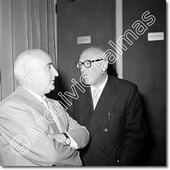 Il trasferimento
dell'agenzia giornalistica da Milano a Roma favorisce gli incontri di
Palmas con l'eccellenza politica italiana. Il suo obiettivo cattura una
serie di immagini dell'allora Presidente della Repubblica Luigi Einaudi,
del Presidente del Consiglio Giuseppe Pella, del Ministro degli Interni
Mario Scelba, di Pietro Nenni e di Alcide De Gasperi, uomo faro di una
Democrazia Cristiana che ha appena cominciato il proprio predominio governativo. Il trasferimento
dell'agenzia giornalistica da Milano a Roma favorisce gli incontri di
Palmas con l'eccellenza politica italiana. Il suo obiettivo cattura una
serie di immagini dell'allora Presidente della Repubblica Luigi Einaudi,
del Presidente del Consiglio Giuseppe Pella, del Ministro degli Interni
Mario Scelba, di Pietro Nenni e di Alcide De Gasperi, uomo faro di una
Democrazia Cristiana che ha appena cominciato il proprio predominio governativo.
Giuseppe
Palmas durante il giorno cerca la notizia o la foto da prima pagina e
riserva la notte alla dolce vita. Locali notturni, teatro di rivista e
di prosa, avanspettacolo. Dimenticate le preoccupazioni, gli Italiani
cominciano ad affollare questi luoghi di svago, dove muovono i primi passi
Dario Fo, qui presente nei panni del giullare, Carlo Dapporto, Erminio
Macario, Wanda Osiris, Oreste Lionello. Garinei e Giovannini firmano giài
loro primi spettacoli e sui palchi dei più famosi teatri d'Italia
si alternano Anna Proclemer, Paolo Stoppa, Johnny Dorelli, Lauretta Masiero,
Gino Cervi.
Prendono
piede le sfilate di moda che valorizzano il gusto italiano, mentre comincia
la sua brillante carriera, a passo di danza, Carla Fracci. Dopo gli spettacoli
il fotoreporter finisce l'ultimo rullino vagando per bar e ristoranti
alla ricerca di qualche faccia significativa. La caccia, spesso, dà
buoni risultati:fra gli altri finiscono in un'inquadratura l'armatore
Aristotele Onassis, lo scrittore Eugenio Montale, il pittore spagnolo
Salvator Dalì, sorpreso ad una festa in compagnia di Charlie Chaplin.
Con Giovannino Guareschi divide una sincera amicizia tanto che lo scrittore,
creatore di Don Camillo, tiene a battesimo la sua primogenita,
Daniela. Non sfuggono ai suoi scatti nemmeno Achille Campanile, il pittore
Michele Cascella, il generale Umberto Nobile (quello della Tenda Rossa)
e Giuseppe Ungaretti.
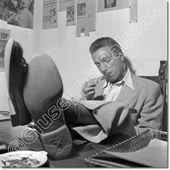 Infine la
Rai. La tecnologia, soprattutto quella televisiva, è ancora giovane.
Anche Mike Bongiorno è molto giovane, ma già conduce un
quiz. Lascia o raddoppia incolla alla TV quelli che hanno la fortuna
di possederne una. Ma tutti hanno almeno un'amico o un parente che possiede
il televisore, cosicchè le immagini diffuse da questo nuovo elettrodomestico
possono essere guardate da milioni di occhi. Infine la
Rai. La tecnologia, soprattutto quella televisiva, è ancora giovane.
Anche Mike Bongiorno è molto giovane, ma già conduce un
quiz. Lascia o raddoppia incolla alla TV quelli che hanno la fortuna
di possederne una. Ma tutti hanno almeno un'amico o un parente che possiede
il televisore, cosicchè le immagini diffuse da questo nuovo elettrodomestico
possono essere guardate da milioni di occhi.
L'agenzia di
Palmas si trova ad un passo dagli studi della Rai. E' relativamente facile
quindi fotografare Mario Riva, presentatore del celebre programma Il Musichiere,
e Nunzio Filogamo mentre saluta gli ascoltatori con la celebre frase "cari
amici vicini e lontani". Fra un annuncio e l'altro di Nicoletta Orsomando
si alternano al timone delle varie trasmissioni Corrado, Enzo Tortora, Raimondo
Vianello e Sandra Mondaini. Molti di questi personaggi sono ancora sulla cresta
dell'onda ai giorni nostri, quasi a voler dimostrare che la televisione rende
piùlongevi della politica.
E quando, fra
cent'anni, anche l'ultima persona fotografata non ci sarà più,
qualcuno guardando queste immagini potrà pensare che in quell'attimo,
in quello scatto, forse il tempo si è davvero fermato.
Roberto
Palmas
 Signs
of color between the grays of black and white Signs
of color between the grays of black and white
by
Roberto Palmas (son of Giuseppe Palmas)
An
exhibit of Giuseppe Palmas' photographs would not be complete without
considering the social aspect. In the section Chronicle and Custom I wanted
to introduce all the personalities and events which colored a nation intent
on licking its wounds left by World War II. I will begin with the chronicle
he recorded from the outset of his career, initially left in notebooks
and later recorded on film.
The
small facts of "cronaca nera", almost as if he didn't want to
give up journalism, give Palmas the opportunity to show his photographic
talent with a little elbowing-in to get the best shot. He was in the front
lines of all the most important court cases of the post war period, trying
to capture the rage of the accused as the verdict was read or, as in the
case of the Countess Maria Pia Bellentani, the joy of being set free.
He pays particular attention to the homeless and those who lost everything
in the war. Significantly, he portrays the "census of the homeless"
taken in 1951. Poor people living in barracks erected from the wreckage
of war are awaken in the middle of the night by policemen, to ensure better
control of the headcount. These "social" photos show that in
spite of the postwar economic boom, many of Italy's problems remained
unresolved.
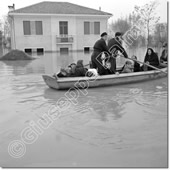 Palmas'
real baptism as a press photographer was the Polesine flood in November,
1951. In the days following the Po River flood, Palmas comes to understand
the importance of the camera as an instrument of documentation. This tragedy
is a tough blow for a country which still hears the echoes of the bombs
of World War II. Nevertheless, Italy raises up it's head one more time.
After a few years Palmas goes back to these places to document the physical
and moral reconstruction. Palmas'
real baptism as a press photographer was the Polesine flood in November,
1951. In the days following the Po River flood, Palmas comes to understand
the importance of the camera as an instrument of documentation. This tragedy
is a tough blow for a country which still hears the echoes of the bombs
of World War II. Nevertheless, Italy raises up it's head one more time.
After a few years Palmas goes back to these places to document the physical
and moral reconstruction.
Another important
event documented by Giuseppe Palmas' camera is the return of Italian prisoners
of war from Russia, nearly ten years after the end of the conflict. Men
who were counted as missing in action actually managed to survive not
only the war, but the long frigid winters on the Steppes. Thus in 1954
Palmas' flash portrays these mysterious figures as they step off the train,
bewildered, their long beards hiding the smiles which show the end of
a long nightmare.
The
vocation of all that can be considered press photographer brings Palmas
various prestigious assignments, mainly those in politics. With Luigi
Barzini Jr., one of the most well-known journalists of the magazine "Epoca",
he flies in the Shah of Iran's private jet as he returns to his homeland
from exile following a coup d'état. Although there was not much
light in the plane, Palmas takes all the time necessary to photograph
Reza Palhevi, finally relaxed and calm. As often happens on these occasions,
the photographer asks a colleague to take a shot of him with the Shah,
as if to become for a moment the protagonist, like at the end of a play
when the director comes out from behind the curtain and goes on the stage
to enjoy the applause he's earned.
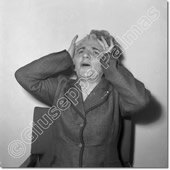 Nor
did Italian politicians elude Palmas' lens, for example Senator Merlin,
who left her mark on Italian history by outlawing brothels. Decades later
the debate on this issue remains open and in her photograph the Senator
seems to exclaim: "Oh my God, what have I done?!" Nor
did Italian politicians elude Palmas' lens, for example Senator Merlin,
who left her mark on Italian history by outlawing brothels. Decades later
the debate on this issue remains open and in her photograph the Senator
seems to exclaim: "Oh my God, what have I done?!"
Palmas' move
from Milan to Rome fosters his encounters with top Italian politicians.
His lens captures a series of images of the then-President of the Republic
Luigi Einaudi, Prime Minister Giuseppe Pella, Interior Minister Mario
Scelba, Socialist leader Pietro Nenni and Alcide De Gasperi, head of the
reigning Christian Democratic party which had just begun to dominate the
government.
While
his days were spent in search of front page news, Giuseppe Palmas reserved
the nights for "la dolce vita" - nightclubs, revue and prose
theater, and curtain-raisers. Forgetting their worries, Italians begin
to throng to these hot spots to see performers like Dario Fo, dressed
up as a jester, as well as Carlo Dapporto, Erminio Macario, Wanda Osiris
and Oreste Lionello. Garinei and Giovannini put on their first shows,
and actors such as Anna Proclemer, Paolo Stoppa, Johnny Dorelli, Lauretta
Masiero and Gino Cervi perform on the stages of Italy's most famous theaters.
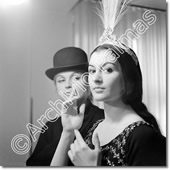 Fashion
shows begin to articulate the "Italian style", while Carla Fracci
launches her career as Italy's most famous ballerina. After the shows
Palmas makes the rounds of cafe's and restaurants in search of famous
people. The hunt often bears good results: among others, those captured
in black and white include the shipbuilder Aristotle Onassis, the author
Eugenio Montale, and the Spanish artist Salvator Dalì, taken by
surprise at a party with Charlie Chaplin. He strikes up such a sincere
friendship with Giovannino Guareschi that the author, creator of Don Camillo,
is invited to the baptism of Palmas' first-born child, Daniela. Others
captured by Palmas' lens include the humorist Achille Campanile, the artist
Michele Cascella, the explorer and General Umberto Nobile (of the red
curtain), and the poet Giuseppe Ungaretti. Fashion
shows begin to articulate the "Italian style", while Carla Fracci
launches her career as Italy's most famous ballerina. After the shows
Palmas makes the rounds of cafe's and restaurants in search of famous
people. The hunt often bears good results: among others, those captured
in black and white include the shipbuilder Aristotle Onassis, the author
Eugenio Montale, and the Spanish artist Salvator Dalì, taken by
surprise at a party with Charlie Chaplin. He strikes up such a sincere
friendship with Giovannino Guareschi that the author, creator of Don Camillo,
is invited to the baptism of Palmas' first-born child, Daniela. Others
captured by Palmas' lens include the humorist Achille Campanile, the artist
Michele Cascella, the explorer and General Umberto Nobile (of the red
curtain), and the poet Giuseppe Ungaretti.
And
finally RAI, the national television broadcaster. Technology, especially
that of television, is still in its infancy. The celebrated TV show host
Mike Bongiorno is very young, but already conducting his first quiz show.
The show "Lascia o Raddoppia" keeps all those fortunate enough
to own a TV glued to the set. But nearly everyone has a friend or relative
with a TV, so that the images conveyed by this new appliance can be seen
by millions.
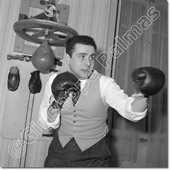 Palmas' agency
just happens to be located around the corner from RAI studios, making
it relatively easy to photograph Mario Riva, announcer of the famous program
"Il Musichiere", and Nunzio Filogamo while he greets audiences with the
famous phrase "cari amici vicini e lontani" [Dear friends far
and wide]. Between Nicoletta Orsomando's announcements hosts including
Corrado, Enzo Tortora, Raimondo Vianello and Sandra Mondaini alternate
at the helm of various programs. Many of these personalities are still
in the spotlight currently, almost as if to show that TV careers are
more long lasting than those in politics. Palmas' agency
just happens to be located around the corner from RAI studios, making
it relatively easy to photograph Mario Riva, announcer of the famous program
"Il Musichiere", and Nunzio Filogamo while he greets audiences with the
famous phrase "cari amici vicini e lontani" [Dear friends far
and wide]. Between Nicoletta Orsomando's announcements hosts including
Corrado, Enzo Tortora, Raimondo Vianello and Sandra Mondaini alternate
at the helm of various programs. Many of these personalities are still
in the spotlight currently, almost as if to show that TV careers are
more long lasting than those in politics.
And when,
a hundred years from now, the last person photographed by Palmas will
be gone, someone who looks at these pictures could imagine that in that
split second, in that click of the shutter, time really stood still.
Roberto
Palmas
|

![]() Sezione Costume
Sezione Costume ![]() Custom Section
Custom Section